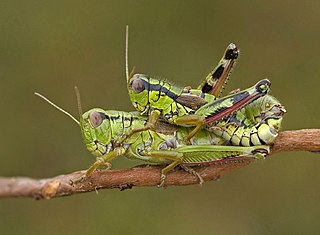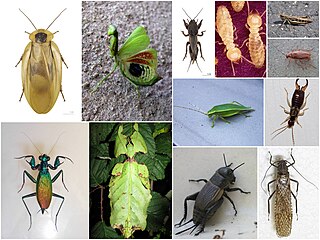
Insects in the family Tettigoniidae are commonly called katydids, or bush crickets. They have previously been known as "long-horned grasshoppers". More than 8,000 species are known. Part of the suborder Ensifera, the Tettigoniidae are the only extant (living) family in the superfamily Tettigonioidea.

Orthoptera is an order of insects that comprises the grasshoppers, locusts, and crickets, including closely related insects, such as the bush crickets or katydids and wētā. The order is subdivided into two suborders: Caelifera – grasshoppers, locusts, and close relatives; and Ensifera – crickets and close relatives.

Ensifera is a suborder of insects that includes the various types of crickets and their allies including: true crickets, camel crickets, bush crickets or katydids, grigs, weta and Cooloola monsters. This and the suborder Caelifera make up the order Orthoptera. Ensifera is believed to be a more ancient group than Caelifera, with its origins in the Carboniferous period, the split having occurred at the end of the Permian period. Unlike the Caelifera, the Ensifera contain numerous members that are partially carnivorous, feeding on other insects, as well as plants.

Bandwings, or band-winged grasshoppers, are the subfamily Oedipodinae of grasshoppers classified under the family Acrididae. They have a worldwide distribution and were originally elevated to full family status as the Oedipodidae. Many species primarily inhabit xeric weedy fields, and some are considered to be important locusts:

The Caelifera are a suborder of orthopteran insects. They include the grasshoppers and grasshopper-like insects, as well as other superfamilies classified with them: the ground-hoppers (Tetrigoidea) and pygmy mole crickets (Tridactyloidea). The latter should not be confused with the mole crickets (Gryllotalpidae), which belong to the other Orthopteran sub-order Ensifera.
Salih Ada is a Turkish island in the Aegean Sea, located north of Bodrum. It is located in the Muğla Province. It is located across Güvercinlik Bay on the Muğla-Bodrum highway. Salih Ada is a popular tourist destination, and is accessible by boat from Bodrum. The hills to the east of the island are covered with pine forest and olive groves.

Acridoidea is the largest superfamily of grasshoppers in the order Orthoptera with species found on every continent except Antarctica.
Myrcia neoelegans, the bashy guava, is a species of flowering plants in the family Myrtaceae. It is endemic to the Lesser Antilles.
Caryanda or Karyanda was a city on the coast of ancient Caria in southwestern Anatolia. Stephanus of Byzantium describes it as a city and harbour (λίμην) near Myndus and Cos. But λιμήν, in the text of Stephanus, is an emendation or alteration: the manuscripts use the word λίμνη ('lake'). Strabo places Caryanda between Myndus and Bargylia, and he describes it, according to the common text, as "a lake, and island of the same name with it;" and thus the texts of Stephanus, who derived his information from Strabo, agree with the texts of Strabo. Pliny simply mentions the island Caryanda with a town; but he is in that passage only enumerating islands. In another passage he mentions Caryanda as a place on the mainland, and Pomponius Mela does so too. Scylax of Caryanda, one of the most famous mariners and explorers of ancient times, was a native of Caryanda. He lived in the late 6th and early 5th centuries BC and served the Persian king Darius I.

Grylloidea is the superfamily of insects, in the order Orthoptera, known as crickets. It includes the "true crickets", scaly crickets, wood crickets and other families, some only known from fossils.

Caryanda is a large genus of grasshoppers in the subfamily Caryandinae. Species are recorded from Africa and Asia.
Caryanda modesta is a species of grasshoppers in the subfamily Caryandinae, found in the Congo Basin.

The cohort Polyneoptera is a proposed taxonomic ranking for the Orthoptera and all other Neopteran insects believed to be more closely related to Orthoptera than to any other insect orders. These winged insects, now in the Paraneoptera, were formerly grouped as the Hemimetabola or Exopterygota on the grounds that they have no metamorphosis, the wings gradually developing externally throughout the nymphal stages.

Tettigoniidea is an infraorder of the order Orthoptera, with six extant families.

Gryllidea is an infraorder that includes crickets and similar insects in the order Orthoptera. There are two superfamilies, and more than 6,000 described species in Gryllidea.
Aster neoelegans is a species of flowering plants in the family Asteraceae. It is found in Bhutan, China and India.
Neapolis (Ancient Greek: Νεάπολις) or Caryanda Neapolis (Karyanda Neapolis) (Ancient Greek: Καρυάνδα Νεάπολις) was a coastal town of ancient Caria. It was located near ancient Myndus and modern Göl. Neapolis was successor of Caryanda, when it was moved early in the 3d century.
Caryanda elegans may refer to:

The Caryandinae are a small subfamily of grasshoppers found mostly in China, India, Indochina and Malesia, but the large type genus Caryanda also has species from Africa. Genera were previously placed in the tribe Oxyini, with the subfamily erected by Yin & Liu in 1987.

Caryanda spuria is a species of short-horned grasshopper in the family Acrididae. It is found mainly in Indonesia, Singapore, and Malaysia.












